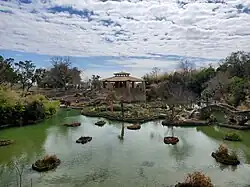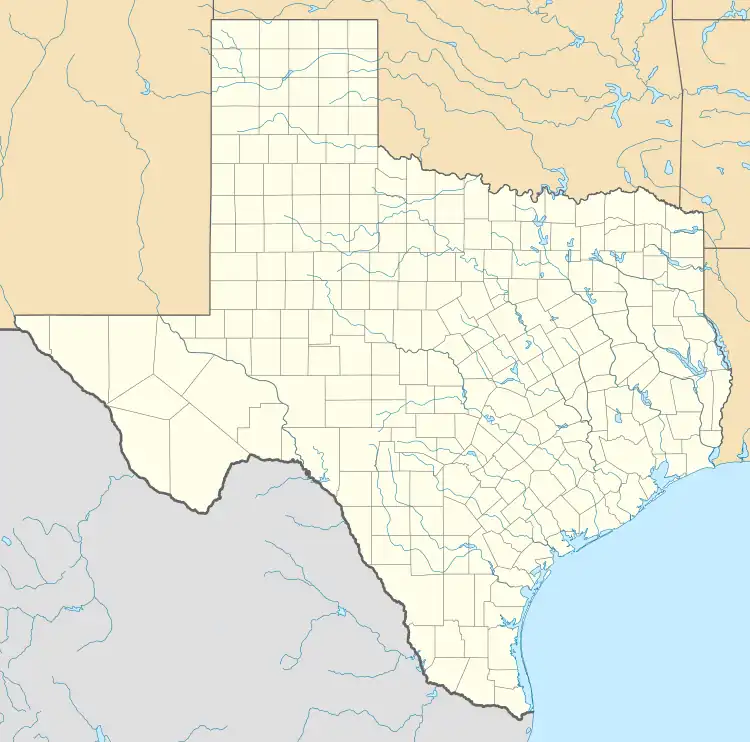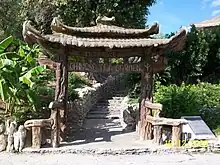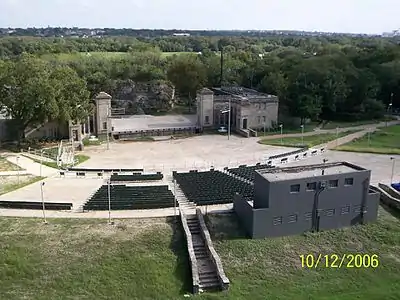San Antonio Japanese Tea Garden
The San Antonio Japanese Tea Garden, or Sunken Gardens in Brackenridge Park, San Antonio, Texas, opened in an abandoned limestone rock quarry in the early 20th century. It was known also as Chinese Tea Gardens, Chinese Tea Garden Gate, Chinese Sunken Garden Gate and is listed on the U.S. National Register of Historic Places. It is located on the northwestern edge of Brackenridge Park, near the San Antonio Zoo.
Chinese Sunken Garden Gate | |
 Japanese Tea Garden in 2022 | |
  | |
| Location | 3853 N. St. Mary's Street San Antonio, Texas 78212 |
|---|---|
| Coordinates | 29°27′40″N 98°28′36″W |
| Built | 1942 |
| Architect | Rodriguez, Dionicio |
| Architectural style | Faux bois sculpture |
| MPS | Sculpture by Dionicio Rodriguez in Texas MPS |
| NRHP reference No. | 04001167[1] |
| Added to NRHP | October 22, 2004 |
History
The San Antonio Japanese Tea Garden (also known as the Sunken Gardens) in the U.S. state of Texas was developed on land donated to the city in 1899 by George Washington Brackenridge, president of the San Antonio Water Works Company. The ground was first broken around 1840 by German masons, who used the readily accessible limestone to supply the construction market. Many San Antonio buildings, including the Menger Hotel, were built with the stone from this quarry on the Rock Quarry Road.[2]
In 1880 the Alamo Cement Company was incorporated and produced cement for 26 years in the kiln, the chimney of which still stands today. Supporting the workforce of the quarry was a small "village", populated primarily by Americans who worked the site. They and their families became popular with tourists, who purchased pottery, hand woven baskets, and food.
About 1917, City Parks Commissioner Ray Lambert visualized an oriental-style garden in the pit of the quarry. His engineer, W.S. Delery, developed plans, and work began when several donors paid for it in 1918 Lambert used prison labor to shape the quarry into a complex that included walkways, stone arch bridges, an island and a Japanese pagoda.[2]
At the entrance to the garden, Mexican-born artist Dionicio Rodriguez (1891-1955) replicated a Japanese Torii gate in his unique style of concrete construction that imitated wood. In 1919, at the city's invitation, Kimi Eizo Jingu, a local Japanese-American artist, moved to the garden. In 1926, they opened the Bamboo Room, where light lunches and tea were sold. Kimi and Miyoshi Jingu maintained the garden, lived in the park, and raised eight children. Kimi was a representative of the Shizuoka Tea Association and was considered an expert in the tea business nationally. He died in 1938, and in 1941 the family was evicted with the rise of anti-Japanese sentiment of World War II.[2]
The garden was renamed the Chinese Tea Garden, to prevent the razing and vandalism of the tea garden during World War II, as many other cities' Japanese tea gardens were being vandalized. A Chinese-American family, Ted and Ester Wu, opened a snack bar in the pagoda until the early 1960s. In 1984, under the direction of Mayor Henry Cisneros, the city restored the original “Japanese Tea Garden” designation in a ceremony attended by Jingu's children and representatives of the Japanese government.[2]
Renovation
For years the garden sat in neglect and disrepair, becoming a target of graffiti and vandalism. Due to limited funding, the city threatened to close the garden, but the community and parks supporters rallied and lobbied to keep it open.[2]
In 2005, the city used about $550,000 in bond money to reroof the pagoda-like Pavilion and the Jingu House.[2]
In 2007, former Councilwoman Bonnie Conner, vice chairwoman of parks projects for the San Antonio Parks Foundation and former Mayor Lila Cockrell, Parks Foundation president, began a $1.6 million restoration campaign to restore the ponds and waterfall in conjunction with the City of San Antonio.[2] For the public re-opening on March 8, 2008, Jingu family members returned to San Antonio. Mabel Yoshiko Jingu Enkoji, the sixth child of Kimi and Miyoshi Jingu, who was born at the Garden, was the senior Jingu family member at the event.[3][4]
In 2009, the San Antonio Parks Foundation and the City of San Antonio began work on the $1 million restoration of the historic Jingu house. Work was completed in October 2011. The building is now a Fresh Horizons Creative Catering restaurant, serving light lunches as the Jingu family did in the 1930s.[3]
In recognition of the Tea Garden's origin as a rock quarry that played a prominent role in the development of the cement business, as well as its later redevelopment as a garden, the site is designated a Texas Civil Engineering Landmark, a Registered Texas Historic Landmark, and listed on the National Register of Historic Places.
The Sunken Garden amphitheater is located to the south. It comprises 879 permanently installed seats and has the option of adding folding chairs for a total general admittance of 2,700. The general admittance (standing room) to the fenced grounds of the theater is 4,800 spectators. The Parks and Recreation Department's Cultural Program assumed management of the theater in the early 1970s. In early 1984, a $320,000 renovation of the theater was completed.[5]
Images
 Tea Garden at Public Opening Mar 8, 2008
Tea Garden at Public Opening Mar 8, 2008 Tea Garden at Public Opening Mar 8, 2008
Tea Garden at Public Opening Mar 8, 2008 Tea Garden at Public Opening Mar 8, 2008
Tea Garden at Public Opening Mar 8, 2008 Tea Garden at Public Opening Mar 8, 2008
Tea Garden at Public Opening Mar 8, 2008 N. St. Mary's Park Entrance
N. St. Mary's Park Entrance View from parking lot to Garden entrance
View from parking lot to Garden entrance Tea Garden entrance
Tea Garden entrance Pagoda and Jingu House
Pagoda and Jingu House Pagoda and Jingu House
Pagoda and Jingu House Pagoda
Pagoda Walkway toward City Zoo. During quarry operations it was used as a cart path.
Walkway toward City Zoo. During quarry operations it was used as a cart path. Historical Sign in front of Kiln
Historical Sign in front of Kiln Cement Kiln
Cement Kiln Sunken Garden Theater 1930 entrance marquee
Sunken Garden Theater 1930 entrance marquee Sunken Garden Amphitheater
Sunken Garden Amphitheater Sunken Garden Amphitheater
Sunken Garden Amphitheater
See also
References
Citations
- "National Register Information System". National Register of Historic Places. National Park Service. July 9, 2010.
- "Japanese Tea Garden at Brackenridge Park" (PDF). San Antonio Parks Foundation. Archived from the original (PDF) on 2010-05-24.
- "Park Projects". San Antonio Parks Foundation. Archived from the original on 2011-05-24.
- Website of the City of San Antonio Parks and Recreation. Park Histories. Retrieved 2010-08-14.
- Pfeiffer, Maria Watson. "Sunken Garden Theater Rental Information". San Antonio Parks and Recreation. City of San Antonio. Retrieved 8 December 2021.
Sources
- Walls, Thomas K. (1987). The Japanese Texans. San Antonio: Institute of Texan Cultures. ISBN 9780867010213. OCLC 16119371.
- City of San Antonio Department of Parks. History of Japanese Tea Garden Rededication Ceremony program, Oct 12, 1984.
- Interview with Mabel Yoshiko Enkoji Jingu, by Michael Nishimuta, at Institute of Texan Cultures, March 7, 2008.
Further reading
External links
- Japanese Tea Garden - official site at San Antonio Parks & Recreation
- Brackenridge Park Photos Amusement Planet Brackenridge Park Photo Gallery
- Japanese Tea Gardens Page Japanese Tea Gardens at Sunken Gardens, San Antonio, Texas
- City of San Antonio Parks & Recreation Department A History of the Japanese Tea Garden Online
- Listing in Texas Historical Commission Source Listing of the garden by the THC
- Russell, Jan Jarboe. Return to Glory? San Antonio Express-News. Oct 24, 2004 San Antonio columnist describes history of gardens
- Arkansas Sculptures of Dionicio Rodriguez The Artist who designed the entrance gate
- Handbook of Texas Online Article describing Dionicio Rodriguez
- City of San Antonio Parks & Recreation Department Sunken Garden Theater History Online
- San Antonio Conventions and Visitors Bureau Japanese Tea Garden and Other Historic Sites